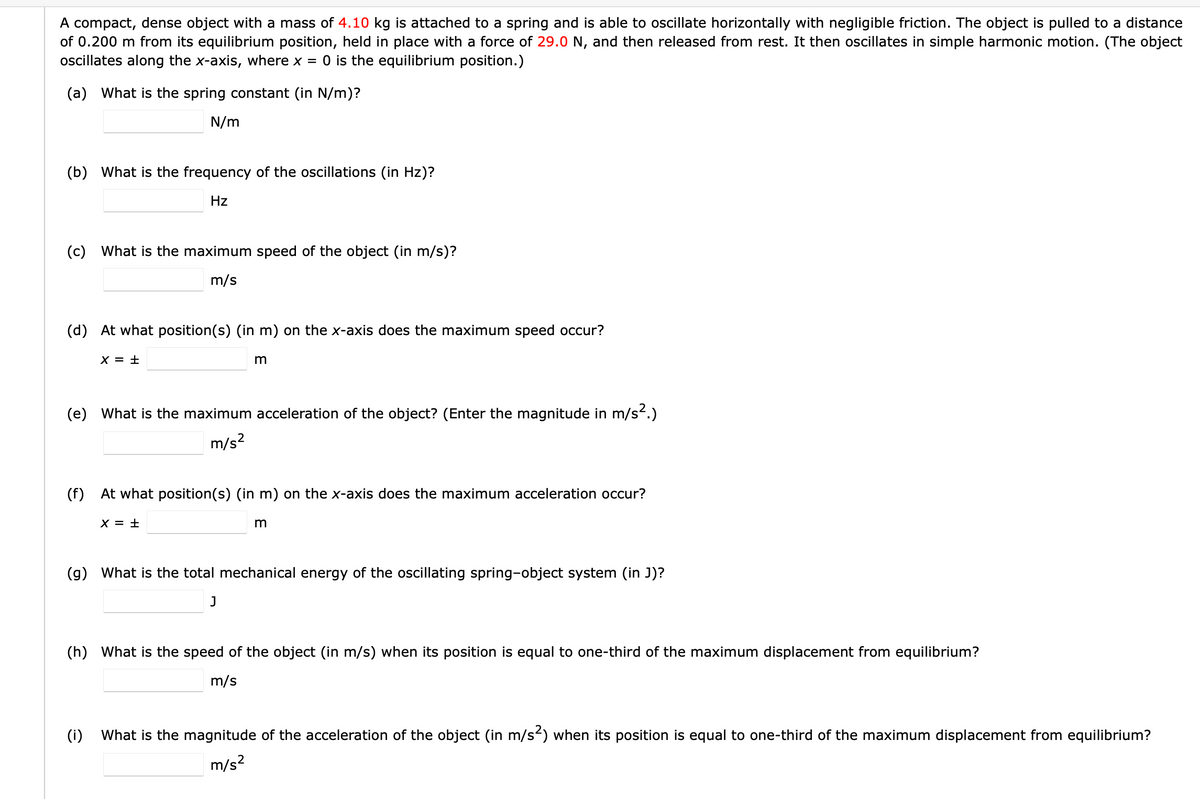A compact, dense object with a mass of 4.10 kg is attached to a spring and is able to oscillate horizontally with negligible friction. The object is pulled to a distance of 0.200 m from its equilibrium position, held in place with a force of 29.0 N, and then released from rest. It then oscillates in simple harmonic motion. (The object ocillates along the x-axis, where x = 0 is the equilibrium position.) (a) What is the spring constant (in N/m)? N/m (b) What is the frequency of the oscillations (in Hz)? Hz (c) What is the maximum speed of the object (in m/s)? m/s (d) At what position(s) (in m) on the x-axis does the maximum speed occur? (e) What is the maximum acceleration of the object? (Enter the magnitude in m/s2.) m/s? (f) At what position(s) (in m) on the x-axis does the maximum acceleration occur? X = ± (g) What is the total mechanical energy of the oscillating spring-object system (in J)? (h) What is the speed of the object (in m/s) when its position is equal to one-third of the maximum displacement from equilibrium? m/s (i) What is the magnitude of the acceleration of the object (in m/s) when its position is equal to one-third of the maximum displacement from equilibrium? m/s2
A compact, dense object with a mass of 4.10 kg is attached to a spring and is able to oscillate horizontally with negligible friction. The object is pulled to a distance of 0.200 m from its equilibrium position, held in place with a force of 29.0 N, and then released from rest. It then oscillates in simple harmonic motion. (The object ocillates along the x-axis, where x = 0 is the equilibrium position.) (a) What is the spring constant (in N/m)? N/m (b) What is the frequency of the oscillations (in Hz)? Hz (c) What is the maximum speed of the object (in m/s)? m/s (d) At what position(s) (in m) on the x-axis does the maximum speed occur? (e) What is the maximum acceleration of the object? (Enter the magnitude in m/s2.) m/s? (f) At what position(s) (in m) on the x-axis does the maximum acceleration occur? X = ± (g) What is the total mechanical energy of the oscillating spring-object system (in J)? (h) What is the speed of the object (in m/s) when its position is equal to one-third of the maximum displacement from equilibrium? m/s (i) What is the magnitude of the acceleration of the object (in m/s) when its position is equal to one-third of the maximum displacement from equilibrium? m/s2
Principles of Physics: A Calculus-Based Text
5th Edition
ISBN:9781133104261
Author:Raymond A. Serway, John W. Jewett
Publisher:Raymond A. Serway, John W. Jewett
Chapter12: Oscillatory Motion
Section: Chapter Questions
Problem 18P
Related questions
Question
need help with d-i

Transcribed Image Text:A compact, dense object with a mass of 4.10 kg is attached to a spring and is able to oscillate horizontally with negligible friction. The object is pulled to a distance
of 0.200 m from its equilibrium position, held in place with a force of 29.0 N, and then released from rest. It then oscillates in simple harmonic motion. (The object
oscillates along the x-axis, where x =
O is the equilibrium position.)
(a) What is the spring constant (in N/m)?
N/m
(b) What is the frequency of the oscillations (in Hz)?
Hz
(c) What is the maximum speed of the object (in m/s)?
m/s
(d) At what position(s) (in m) on the x-axis does the maximum speed occur?
X = +
(e) What is the maximum acceleration of the object? (Enter the magnitude in m/s2.)
m/s?
(f) At what position(s) (in m) on the x-axis does the maximum acceleration occur?
X = ±
m
(g) What is the total mechanical energy of the oscillating spring-object system (in J)?
(h) What is the speed of the object (in m/s) when its position is equal to one-third of the maximum displacement from equilibrium?
m/s
(i)
What is the magnitude of the acceleration of the object (in m/s) when its position is equal to one-third of the maximum displacement from equilibrium?
m/s?
Expert Solution
This question has been solved!
Explore an expertly crafted, step-by-step solution for a thorough understanding of key concepts.
This is a popular solution!
Trending now
This is a popular solution!
Step by step
Solved in 6 steps

Knowledge Booster
Learn more about
Need a deep-dive on the concept behind this application? Look no further. Learn more about this topic, physics and related others by exploring similar questions and additional content below.Recommended textbooks for you

Principles of Physics: A Calculus-Based Text
Physics
ISBN:
9781133104261
Author:
Raymond A. Serway, John W. Jewett
Publisher:
Cengage Learning

Physics for Scientists and Engineers, Technology …
Physics
ISBN:
9781305116399
Author:
Raymond A. Serway, John W. Jewett
Publisher:
Cengage Learning

Physics for Scientists and Engineers
Physics
ISBN:
9781337553278
Author:
Raymond A. Serway, John W. Jewett
Publisher:
Cengage Learning

Principles of Physics: A Calculus-Based Text
Physics
ISBN:
9781133104261
Author:
Raymond A. Serway, John W. Jewett
Publisher:
Cengage Learning

Physics for Scientists and Engineers, Technology …
Physics
ISBN:
9781305116399
Author:
Raymond A. Serway, John W. Jewett
Publisher:
Cengage Learning

Physics for Scientists and Engineers
Physics
ISBN:
9781337553278
Author:
Raymond A. Serway, John W. Jewett
Publisher:
Cengage Learning

Physics for Scientists and Engineers with Modern …
Physics
ISBN:
9781337553292
Author:
Raymond A. Serway, John W. Jewett
Publisher:
Cengage Learning

Classical Dynamics of Particles and Systems
Physics
ISBN:
9780534408961
Author:
Stephen T. Thornton, Jerry B. Marion
Publisher:
Cengage Learning

Physics for Scientists and Engineers: Foundations…
Physics
ISBN:
9781133939146
Author:
Katz, Debora M.
Publisher:
Cengage Learning